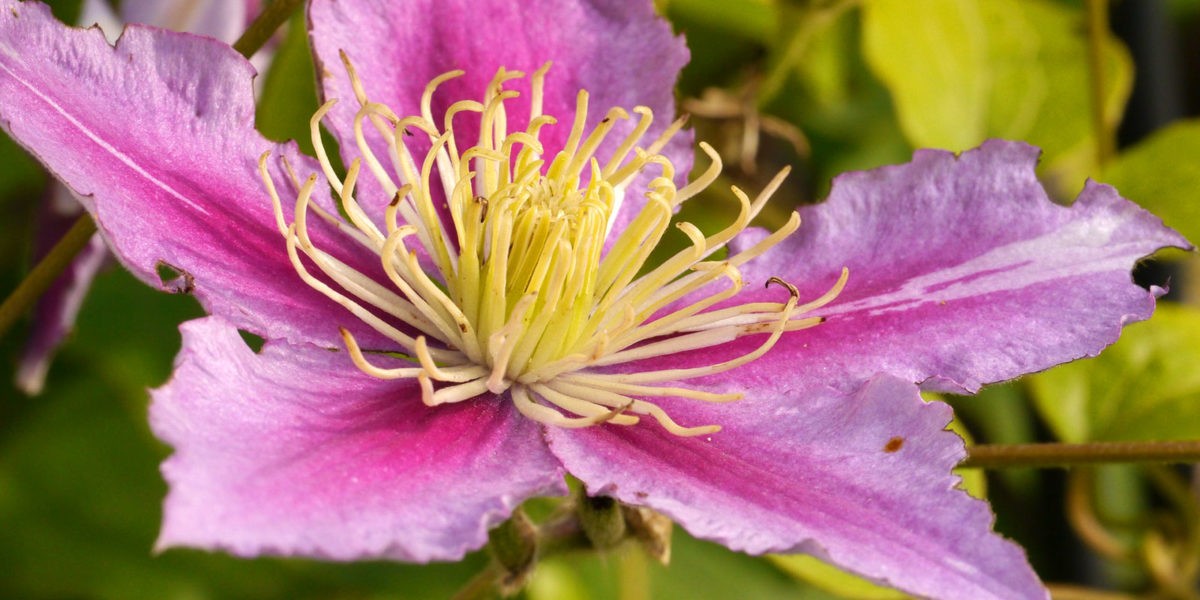
Clematis are climbing plants very appreciated for the diversity and beauty of their large flowers.
They associate very well with hedges, trees, shrubs and roses. Clematis belong to the Ranunculaceae family and are among the climbers that offer the most variety in shapes and colors. They do not have spikes like ivy and need a support to flourish: trellis against a wall, fence, tree, pergola… They can reach 10 m high and offer an abundant bloom.
Their development being fast, they quickly cover their support. Many different varieties of clematis exist: deciduous or evergreen, with small or very large flowers, blooming from March to November. They come in all colors, from violet blue to soft pink, not forgetting white or yellow. Rustic, clematis can withstand cold and frost down to -10°C
Planting clematis
You can plant them from fall to spring, avoiding periods of frost. Clematis like to have their roots in the shade and their flowers in the sun! Choose a piece of land on the south or west side.
To protect the feet from the heat, cover them with a tile for example. Start by digging a hole of at least 40 cm on each side and 50 cm deep. At the bottom, create a drainage bed with large gravels, then fill in part of the hole. Place the root ball lying on this mound, so as to bury about ten centimeters of the stems at the base. Then backfill by mixing well-decomposed organic matter and fertilizer with the original soil.
Wrap a protective sleeve around the branches coming out of the soil. You can use a mineral water bottle without the base and neck. Then, place the spindly stems on their future support. Then, provide a watering basin while waiting to spread a thick mulch (flax straw, hemp, lawn clippings, …) on 5 to 10 cm.
Finally, water moderately to settle the soil. Plant a small shrub nearby, such as a lavender plant or a charcoal tree, to protect the base of your clematis from full sun, but also and above all to pump out excess water. Tips: Clematis can be combined with climbing roses or honeysuckle, but be sure to match the colors.
Maintaining your clematis
If you follow the planting advice, your clematis will not require too much maintenance: a little pruning and adequate watering. Pruning To encourage your clematis to bloom and branch out, consider pruning them. The more you prune them, the more they bloom! Always do this after flowering and before vegetation, so as not to lose a year’s worth of flowers. For small-flowered varieties that bloom in spring, prune in summer. Eliminate the dead wood and cut back the old, stunted or too invasive stems to 1/3. This is called selective pruning. For the other varieties, prune at the end of winter, in February or March.
Cut back the stems that flowered the previous year to about 40/50 cm from the ground. Then, cut off the dead wood and the most fragile stems. This is the radical pruning. Watering Water well the first 2 years after planting, especially during dry periods. Indeed, clematis like humid, fresh and well-drained soils. Please keep the soil slightly moist, but not excessively so.
A mulch will help you to keep a certain freshness and to limit water evaporation. After 2 years, water only in summer or in dry periods, at the foot, every ten to fifteen days. Avoid misting the foliage to avoid the appearance of cryptogamic diseases. It is not necessary to bring fertilizer.
Did you know that?
The genus Clematis counts more than 200 species. Clematis are native to Japan and China. In the Far East, they are considered a symbol of lasting love. This is why stylized clematis often adorn wedding kimonos in Japan. In France, in the Middle Ages, it was called “beggar’s herb” because, when in contact with the skin, it causes redness. The beggars rubbed their limbs with it to soften the passers-by.

